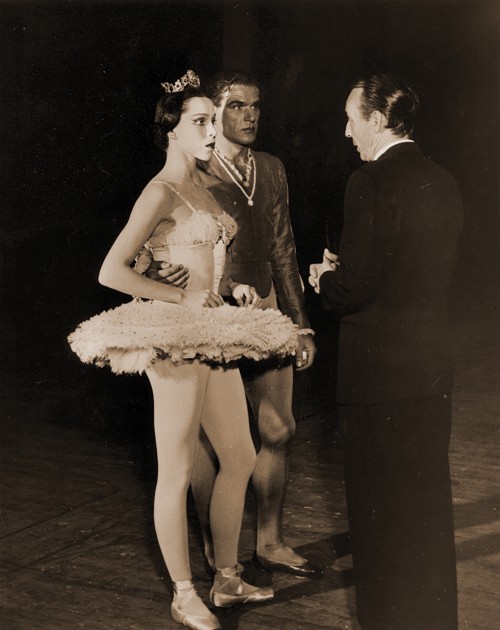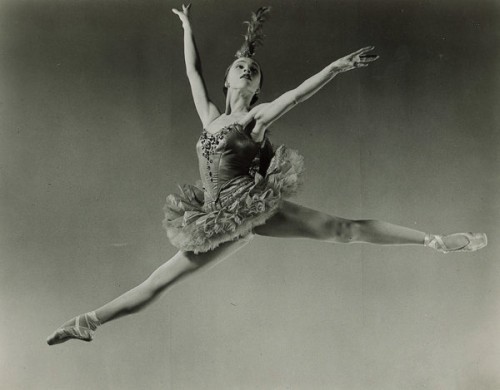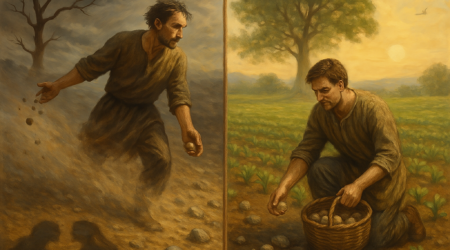Maria Tallchief: Ballet Legend Remembered
Maria Tallchief, daughter of an Oklahoma oil family who grew up on an Indian reservation, found her way to New York and became one of the most brilliant American ballerinas of the 20th century. The art of Maria Tallchief, who died on April 11, 2013 at the age of 88, was recently remembered in the […]
Maria Tallchief, daughter of an Oklahoma oil family who grew up on an Indian reservation, found her way to New York and became one of the most brilliant American ballerinas of the 20th century. The art of Maria Tallchief, who died on April 11, 2013 at the age of 88, was recently remembered in the newly presented “Nikolai and the Others,” the beautiful drama about dance, life and love, which premiered at the Lincoln Center’s Mitzi E. Newhouse Theater in New York.
Written by Richard Nelson, the play centers around the imaginary relationship between composer Igor Stravinsky and the iconic choreographer George Balanchine as it dramatizes “Orpheus,” the ballet classic composed by Igor Stravinsky and choreographed by George Balanchine for Maria Tallchief, his muse and wife, whom he married when she was nineteen.

Maria Tallchief, one of the prominent soloists at the Ballet Russe de Monte Carlo, where she met Balanchine, remained under contract with the company until 1947. But when Balanchine started the Ballet Society company, which later became the renowned New York City Ballet, Maria joined the company in New York where she achieved her international fame, dazzling audiences with her speed, energy, and fire. Not surprisingly, the part that established her national and international acclaim was the title role in the version of Stravinsky’s “Firebird,” just one of many striking roles that Balanchine created for her, along with the role of Swan Queen in his version of “Swan Lake,” the Sugar Plum Fairy in his version of “The Nutcracker,” Eurydice in “Orpheus,” and principal roles in such works as “Scotch Symphony,” which I suspect was in honor of Maria’s Scottish-Irish heritage on her mother’s side.
At the New York City Ballet, Ms. Tallchief’s partners included André Eglevsky, Erik Bruhn, and Nicholas Magallanes. She appeared with Rudolf Nureyev on television and on tour in Europe and made guest appearances with Ruth Page’s Chicago Opera Ballet, the San Francisco Ballet, the Royal Danish Ballet, and the Hamburg Ballet.
In her autobiography, “Maria Tallchief – America’s Prima Ballerina,” published in 1997, Maria pays tribute to Balanchine by writing, “He was admired as the greatest choreographer of our time – perhaps of all time. It was his knowledge of what I could do on my part that made me a prima ballerina. He guided me my whole life not only when I danced for him, but also during our marriage. I could not imagine the world without him.” Tallchief adds, ”A Golden Age of ballet had taken place in New York City, and George, almost single-handedly, was responsible for its glory. And I was a part of it.”

Although their marriage was annulled in 1952, they remained very close friends until his death on April 30, 1983, with Maria at his bedside. “It was an unusual marriage,” she wrote in her autobiography. “Passion and romance didn’t play a big part in our married life. We saved our emotions for the classroom.” Yet she added, “George was a warm, affectionate, loving husband.”
After she and Balanchine were divorced, she remained with the company until 1965. But she also took time off to dance with other companies and she portrayed Anna Pavlova in the Hollywood movie “Million Dollar Mermaid” in 1952, starring famous actress Esther Williams.
Born Elizabeth Marie Tall Chief on Jan. 24, 1925 in Fairfax, Oklahoma as a daughter of a full-blooded Osage Indian father Alexander Joseph Tall Chief, whom his daughters idolized, and the former Ruth Porter. Ms. Tallchief left Oklahoma at an early age, but she was long associated with the state. She was one of five dancers of Indian heritage, all born at roughly the same time, who came to be called the Oklahoma Indian Ballerinas. The others included her younger sister, Marjorie Tallchief, along with Rosella Hightower, Moscelyne Larkin, and Yvonne Chouteau.
Growing up at a time when many American dancers adopted Russian stage names, Ms. Tallchief, proud of her Indian heritage, refused to do so even though friends told her that it would be easy to transform Tallchief into Tallchieva. Ms. Tallchief and her sister, also a ballerina, joined their surnames when they began dancing professionally.
In my phone conversation with Edward Villella, dancer, choreographer, and frequently cited as America’s most celebrated male ballet dancer at the time said, “Maria was considered one of the best American Ballet dancers. She was terrifically professional, fully in command of her role on stage. She was dynamic in her approach to the steps, very sharp, very much of the bravura dancer.” Villella, who was the Artistic Director of the Miami Ballet Company and was just appointed the chairman of the jurors for the 2014 Jackson International Dance Competition adds, “Maria was very proud to be the first Native American Indian prima ballerina. She was an inspiration for the young student dancers and to those who danced with her.”

While communicating with the spectacular prima ballerina Cynthia Gregory, who danced for thirty years in just about every major ballet ever written and was partnered with her most illustrious contemporaries including Mikhail Baryshnikov and Rudolf Nureyev, I found out that Ms. Gregory was one of these young dancers in awe of Ms. Tallchief, “I grew up watching Maria Tallchief dance when the NYC Ballet would visit Los Angeles in the summertime. She was my idol! When I was nine years old I got to be in their Nutcracker as a child in the first act. It was so exciting! I actually saw her backstage!” Now a resident of Las Vegas, Nevada where she is the artistic adviser to the Nevada Ballet Theatre and director of the Cynthia Gregory Center for Coaching, Ms. Gregory adds, “Later when I joined the American Ballet Theater, she was a guest artist and I was able to meet her and watch her up close. Maria had a strong presence both onstage and off. I loved and admired her dynamic personality and strong technique. She was a true ballerina and a force in American dance.”
Recipient of numerous awards both national and international, Maria was honored in 1953 as “The Woman of the Year” by President Eisenhower and in 1996 she was applauded and honored at the Kennedy Center in Washington, D.C. In 1999, President Clinton presented Ms. Tallchief with the National Medal of the Arts. “Maria Tallchief took what had been a European art form and made it America’s own — how fitting that a Native American woman would do that,” said President Clinton at The White House reception. “George Balanchine once told audiences not to analyze ballet. ‘Words cannot describe it,’ he said, ‘you cannot explain a flower.’ So it’s impossible to explain the radiance and grace of Maria Tallchief.”
Remembering Maria Tallchief in the NY Times article on April 12, 2013, choreographer and magnificent ballet dancer Jacques d’Amboise, whom I met and used to watch and admire in New York, compared Ms. Tallchief to two of the century’s greatest ballerinas: Galina Ulanova of the Soviet Union and Margot Fonteyn of Britain. “When you thought of Russian ballet, it was Ulanova. With English ballet, it was Fonteyn. For American ballet, it was Tallchief. She was grand in the grandest way.”
In honor of the passing of Maria Tallchief, “Words on Dance” will host the San Francisco premiere screening of a rare 1998 interview of Tallchief, titled “Maria Tallchief in Conversation with Evelyn Cisneros,” by former SF Ballet Principal Dancer Evelyn Cisneros at the Vogue Theater in San Francisco on Monday, July 15 at 7PM. The film is a concise history of Tallchief’s career in her own words, accompanied by rare film clips of her historical performances, including partnerships with Rudolf Nureyev and Eric Bruhn on “Bell Telephone Hour” television broadcasts and at Jacob’s Pillow Dance Festival in ballets such as Firebird and Sylvia. For tickets and information visit wordsondance.org.
Lina Broydo immigrated from Russia, then the Soviet Union, to Israel where she was educated and got married. After working at the University in Birmingham, England she and her husband immigrated to the United States. She lives in Los Altos Hills, CA and writes about travel, art, style, entertainment, and sports. She hardly cooks or bakes, not the best of «balabostas» her beloved beautiful Mom, Dina, was hoping for. Therefore, she makes reservations and enjoys dining out.
Maria Tallchief,американские балерины, Rudolf Nureyev, Balanchine
Lina Broydo





